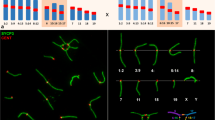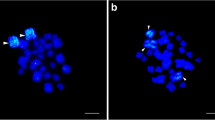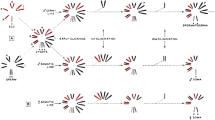Abstract
It was shown that the translocation in study is X-linked. After testcrossing translocation heterozygous males they generally only produce translocation heterozygous daughters and normal sons. The small acrocentric chromosomes involved in the translocation appeared to be the sex-chromosomes. The X-chromosome has a secondary constriction which is missing in the (male determining) Y-chromosome. Meiotic orientation was studied in translocation heterozygous males and females. The alternate and adjacent I orientations were found in about equal frequencies. Further, numerical meiotic non-disjunction (two types) occurred in translocation heterozygous males (about 2%), but is much higher in females (18.7%). In (achiasmate) males the homologous centromeres predominantly regulate meiotic pairing, coorientation and disjunction, apparently independently of the chromosomal rearrangement. Disturbed telomere pairing in particular leading to reduced chiasma frequency most probably explains the high numerical non-disjunction in chiasmate females. A rather good relationship exists between the percentage “semi”-sterility (28%), scored as late embryonic lethals (eggs, 72 hrs.) and the percentage karyotypes (20%) in young eggs (8–16 hrs.) with a large chromosomal deficiency. The remaining sterility (8%) can be explained by the somewhat decreased viability of tertiary trisomics and duplication karyotypes at the end of the egg stage. This translocation behaves like a “simple” one.
Similar content being viewed by others
Literature
Borstel, R. C. von: Inherited partial sterility in Habrobracon. Genetics today. I. Proc. XI Int. Congr. Genet. (S. J. Geerts, ed.), p. 124–125 (1963)
Borstel, R. C. von, Rekemeyer, M. L.: Radiation-induced and genetically contrived dominant lethality in Habrobracon and Drosophila. Genetics 44, 1053–1074 (1959)
Boyes, J. W.: Somatic chromosomes of higher diptera. III Interspecific and intraspecific variation in the genus Hylemya. Canad. J. Zool. 32, 39–63 (1954)
Brink, R. A., Cooper, D. C.: A structural change in the chromosomes of maize leading to chain formation. Amer. Naturalist 66, 310–322 (1932)
Curtis, C. F., Southern, D. J., Pell, P. E., Craig-Cameron, T. A.: Chromosome translocations in Glossina austeni. Genet. Res. (Camb.) 20, 101–113 (1972)
Eicher, E. M.: Translocation trisomic mice: production by female but not male translocation carriers. Science 180, 81 (1973)
Heemert, C. van: Isolation of a translocation homozygote in the onionfly Hylemya antiqua (Meigen) with a cytogenetic method in combination with the determination of the percentage late embryonic lethals. Genen Phaenen 16, 17–18 (1973)
Heemert, C. van: Meiotic disjunction and embryonic lethality in trisomics derived from an X-linked translocation in the onion fly. Chromosoma (Berl.) (in press, 1974)
Hiroyoshi, T.: Sex-limited inheritance and abnormal sex ratio in strains of the housefly. Genetics 50, 373–385 (1964)
Imaizumi, T.: Recherches sur l'expression des facteurs létaux héréditaires chez l'embryon de la Drosophile. VII. Sur les effects létaux dus à l'hypoploïdie et à l'hyperploïdie de chromosomes dans les souches d'XXY et de translocation chez Drosophila melanogaster. Cytologia (Tokyo) 27, 212–228 (1962)
Jaylet, A.: Création d'une lignée homozygote pour une translocation reciproque chez l'amphibien Pleurodeles waltlii. Chromosoma (Berl.) 34, 383–423 (1971)
John, B., Hewitt, G. M.: A spontaneous interchange in Chorthippus brunneus with extensive chiasma formation in an interstitial segment. Chromosoma (Berl.) 14, 638–650 (1963)
John, B., Lewis, K. R.: The meiotic system. Protoplasmatologia vol. VI/F/1. Wien-New York: Springer 1965
Jost, E., Laven, H.: Meiosis in translocation heterozygotes in the mosquito Culex pipiens. Chromosoma (Berl.) 35, 184–205 (1971)
La Chance, L. E., Riemann, J. G., Hopkins, D. E.: A reciprocal translocation in Cochliomyia hominivorax (Diptera: Calliphoridae). Genetic and cytological evidence for preferential segregation in males. Genetics 49, 959–972 (1964)
Lewis, K. R., John, B.: A spontaneous interchange in Chorthippus brunneus. Chromosoma (Berl.) 14, 618–637 (1963)
Poulson, D. F.: The effects of certain X-chromosome deficiencies on the embryonic development of Drosophila melanogaster. J. exp. Zool. 83, 272–325 (1940)
Scriba, M. E. L.: Embryonale Entwicklungsstörungen bei Defizienz und Tetraploidie des 2. Chromosoms von Drosophila melanogaster. Roux' Arch. Entwickl.-Mech. Org. 159, 314–345 (1967)
Searle, A. G., Ford, C. E., Beechy, C. V.: Meiotic disjunction in mouse translocations and the determination of centromere position. Genet. Res. (Camb.) 18, 215–235 (1971)
Ullerich, F. H.: Geschlechtschromosomen und Geschlechtsbestimmung bei einigen Calliphorinen (Calliphoridae, Diptera). Chromosoma (Berl.) 14, 45–110 (1963)
Ullerich, F.-H., Bauer, H., Dietz, R.: Geschlechtsbestimmung bei Tipuliden (Nematocera, Diptera). Chromosoma (Berl.) 15, 591–605 (1964)
Wijnands-Stäb, K. J. A., Heemert, C. van: Radiation induced semisterility for genetic control purposes in the onionfly Hylemya antiqua (Meigen) I. Isolation of semisterile stocks and their cytogenetical properties. Theor. Appl. Genet. 44, 111–119 (1974)
Wright, T. R. F.: The genetics of embryogenesis in Drosophila. Advanc. Genet. 15, 262–395 (1971)
Würgler, F. E., Lütolf, H.-U.: The frequency of meiotic primary nondisjunction of the large autosomes in Drosophila melanogaster. Arch. Genetik 45, 126–128 (1972)
Author information
Authors and Affiliations
Additional information
This paper precedes a second one (van Heemert, 1974) about different trisomic types derived from translocation heterozygous parents. There the same aspects as presented here will be discussed.
Rights and permissions
About this article
Cite this article
van Heemert, C. Meiotic disjunction, sex-determination and embryonic lethality in an X-linked “Simple” translocation of the onion fly, Hylemya antiqua (Meigen). Chromosoma 47, 45–60 (1974). https://doi.org/10.1007/BF00326270
Received:
Accepted:
Issue Date:
DOI: https://doi.org/10.1007/BF00326270




